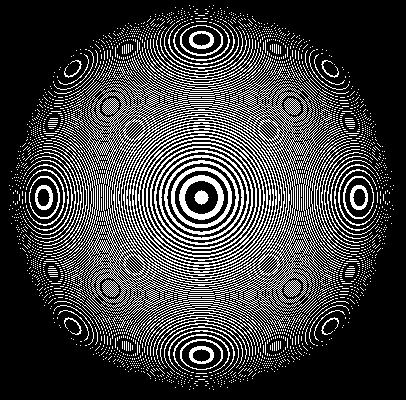
Equation art: art in which the colour of each point is defined by mathematical functions of its coordinates
In December 2003, I was a Computer Science undergraduate on Christmas holidays. As a holiday project, I tried to write a ray-tracer. I knew very little about this, and I tried to write the whole thing from scratch. Oddly enough, I failed. I didn't even come remotely close to writing a working ray tracer.
What I came up with was some strange but ultimately simple code which generated a fairly attractive abstract pattern. It occurred to me that this might be a useful thing to generalise, so I went from there.
This is not the place for a full explanation of how ray tracers work. If you're curious enough, try Google. The best ray-tracer I'm aware of is the Persistence Of Vision (POV) Raytracer, so POV is a useful search term to include. Beyond that, you're on your own.
The simple explanation of what a raytracer does is that it retraces the paths followed by rays of light before they reach the eye.
I used a few simplifications to bring this within my programming ability - I assumed that the rays were perpendicular to the surface of the eye, and I modelled the 'scene' as a surface on which intensity depended on distance from a midpoint. These simplifications completely destroyed the concept, but that's not the point.
The way my final attempt worked, the brightness of each point was set according to a function of its X and Y coordinates. The result can be seen at the bottom of this page. I saw (some of) the possibilities, and I developed this art further.
As soon as I saw the potential, I headed to Google to see if it had been done before. I searched high and low, and I couldn't find anything. I found a thing called algorithm art, which includes both equation art and fractal art, but equation art itself appeared to be a new concept. I then coined the term, and went from there.
Since the end of 2003, I have made hundreds of different images with this method. My specific techniques and understanding have become exceedingly sophisticated, but the basic concept is still the same. I have discovered that I am not the only person to do equation art - I'm simply the first person to realise its possibilities.
Until about early September 2005, I was the only person to have explored equation art in any depth. Here are the people who have dabbled in it - I'll get to my partner in crime shortly.
People who have dabbled in equation art:
Andrew McCann, one of the admins at deviantART.com, made a few equation art images on his own. As far as I know, he's the only person to have reinvented the concept independent of me. He didn't apparently give much thought to the possibilities, however. His page is here
Patrick Carroll, a guy I know from deviantART.com, worked with me rather briefly on equation art. I think it was his idea to adapt the idea to animation, but I'm not sure. His page is here
Richard Grantham, a guy I know from uni, dabbled briefly in equation art. He wrote a Java implementation from scratch in scraps of an otherwise boring lab class - impressive, really. His page is here
My partner in crime:
Back in mid-2004, when I'd been doing equation art for about 6 months, I tried to convince my close friend Bec Skinner to try it.
Somehow, she just didn't get around to it. I forgot the idea, and continued with my own exploration of equation art.
At the end of August 2005, Bec mentioned in a LiveJournal entry that she wished she could make pretty pictures. I immediately suggested she try equation art, since the hard part is programming and she's a better programmer than me. She did try it, and turned out to be pretty good at it. She recreated 'Three Tequila' very accurately, and very soon produced some impressive pieces of her own.
I'm rewriting this in January 2006. Hopefully I'll update this from time to time. Don't hold your breath.
I'm not sure what to say about the present and future of equation art. Bec and I are obviously going to be watching each other's work pretty closely and exchanging suggestions, and I have absolutely no idea what we might come up with. Stay tuned...

My very first piece of equation art, Moonscape. This isn't in my actual gallery, since its artistic merit is rather dubious.